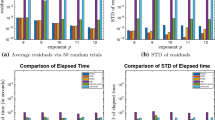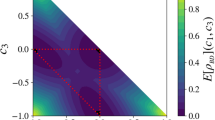Abstract
Qualifying the entanglement of a mixed multipartite state by gauging its distance to the nearest separable state of a fixed rank is a challenging but critically important task in quantum technologies. Such a task is computationally demanding partly because of the necessity of optimization over the complex field in order to characterize the underlying quantum properties correctly and partly because of the high nonlinearity due to the multipartite interactions. Representing the quantum states as complex density matrices with respect to some suitably selected bases, this work offers two avenues to tackle this problem numerically. For the rank-1 approximation, an iterative scheme solving a nonlinear singular value problem is investigated. For the general low-rank approximation with probabilistic combination coefficients, a projected gradient dynamics is proposed. Both techniques are shown to converge globally to a local solution. Numerical experiments are carried out to demonstrate the effectiveness and the efficiency of these methods.






Similar content being viewed by others
Explore related subjects
Discover the latest articles, news and stories from top researchers in related subjects.Data Availability Statements
The datasets generated during and/or analyzed during the current study are available from the corresponding author on reasonable request.
Notes
The very same notation \(\otimes \) has been used for many different meanings in the literature. The distinction between a tensor product and the Kronecker product is necessary for computation and will be explained in Footnote 2. For a general composite system \({\mathscr {H}}_{1} \otimes {\mathscr {H}}_{2}\), we emphasize that \(\otimes \) is merely a bilinear map.
The tensor product of tensors leads to a multi-indexed array. While the way to enumerate its elements is often immaterial in theory, it is essential to enumerate them consistently for numerical calculation. One general rule adopted is that the indices of the leftmost tensor are counted first, e.g., the indices in the tensor product \({\mathbf {a}} \circ {\mathbf {b}}\) of two vectors are enumerated in the same way as the matrix \({\mathbf {a}}{\mathbf {b}}^{\top }\). The relationship (2.3) therefore follows.
References
Einstein, A., Podolsky, B., Rosen, N.: Can quantum-mechanical description of physical reality be considered complete? Phys. Rev. 47, 777–780 (1935). https://doi.org/10.1103/PhysRev.47.777
Friis, N., Vitagliano, G., Malik, M., Huber, M.: Entanglement certification from theory to experiment. Nat. Rev. Phys. 1, 72–87 (2019). https://doi.org/10.1038/s42254-018-0003-5
Gühne, O., Tóth, G.: Entanglement detection. Phys. Rep. 474, 1–75 (2009). https://doi.org/10.1016/j.physrep.2009.02.004
Horodecki, R., Horodecki, P., Horodecki, M., Horodecki, K.: Quantum entanglement. Rev. Mod. Phys. 81, 865–942 (2009). https://doi.org/10.1103/RevModPhys.81.865
Dahl, G., Leinaas, J.M., Myrheim, J., Ovrum, E.: A tensor product matrix approximation problem in quantum physics. Linear Algebra Appl. 420, 711–725 (2007). https://doi.org/10.1016/j.laa.2006.08.026
Kye, S.-H.: Necessary conditions for optimality of decomposable entanglement witnesses. Rep. Math. Phys. 69, 419–426 (2012). https://doi.org/10.1016/S0034-4877(13)60007-5
Thirring, W., Bertlmann, R.A., Köhler, P., Narnhofer, H.: Entanglement or separability: the choice of how to factorize the algebra of a density matrix. Eur. Phys. J. D 64, 181–196 (2011). https://doi.org/10.1140/epjd/e2011-20452-1
Aaronson, S.: Quantum Computing Since Democritus. Cambridge University Press, Cambridge (2013). https://doi.org/10.1017/CBO9780511979309
Hiai, F., Petz, D.: Introduction to matrix analysis and applications, Universitext, Springer, Cham; Hindustan Book Agency. New Delhi (2014). https://doi.org/10.1007/978-3-319-04150-6
Nakahara, M., Ohmi, T.: Quantum Computing: From Linear Algebra to Physical Realizations. CRC Press, Boca Raton (2008). https://doi.org/10.1201/9781420012293
Nielsen, M.A., Chuang, I.L.: Quantum Computation and Quantum Information. Cambridge University Press, Cambridge (2010). https://doi.org/10.1017/CBO9780511976667
Karam, R.: Why are complex numbers needed in quantum mechanics? some answers for the introductory level. Am. J. Phys. 88, 39–45 (2020). https://doi.org/10.1119/10.0000258
Renou, M.-O., Trillo, D., Weilenmann, M., Le, T. P., Tavakoli, A., Gisin, N., Acín, A., Navascués, M.: Quantum theory based on real numbers can be experimentally falsified, Nature, 1–5 (2021). https://doi.org/10.1038/s41586-021-04160-4
Chen, K., Wu, L.-A.: A matrix realignment method for recognizing entanglement. Quantum Inf. Comput. 3, 193–202 (2003). https://doi.org/10.26421/QIC3.3-1
Werner, R.F.: Quantum states with Einstein–Podolsky–Rosen correlations admitting a hidden-variable model. Phys. Rev. A 40, 4277–4281 (1989). https://doi.org/10.1103/PhysRevA.40.4277
Horodecki, M., Horodecki, P., Horodecki, R.: Mixed-State Entanglement and Quantum Communication, pp. 151–195. Springer, Berlin, Heidelberg (2001). https://doi.org/10.1007/3-540-44678-8_5
Chen, L., Aulbach, M., Hajdušek, M.: Comparison of different definitions of the geometric measure of entanglement. Phys. Rev. A 89, 042305 (2014). https://doi.org/10.1103/PhysRevA.89.042305
Leinaas, J.M., Myrheim, J., Ovrum, E.: Geometrical aspects of entanglement. Phys. Rev. A (3) 74, 012313, 13 (2006). https://doi.org/10.1103/PhysRevA.74.012313
Golub, G.H., Van Loan, C.F.: Matrix computations. In: Johns Hopkins Studies in the Mathematical Sciences, 4 edn. Johns Hopkins University Press, Baltimore (2013)
Webster, R.: Convexity. Oxford Science Publications, The Clarendon Press, Oxford University Press, New York (1994)
Jia, Z.-A., Zhai, R., Yu, S., Wu, Y.-C., Guo, G.-C.: Hierarchy of genuine multipartite quantum correlations, Quantum Inf. Process., 19 (2020), pp. Paper No. 419, 13. https://doi.org/10.1007/s11128-020-02922-z
Kolda, T.G., Bader, B.W.: Tensor decompositions and applications. SIAM Rev. 51, 455–500 (2009). https://doi.org/10.1137/07070111X
Vervliet, N., Debals, O., Sorber, L., Van Barel, M., De Lathauwer, L.: Tensorlab 3.0 (2016). https://www.tensorlab.net
Chu, M.T., Lin, M.M.: Nonlinear power-like and SVD-like iterative schemes with applications to entangled bipartite rank-1 approximation. SIAM J. Sci. Comput. 43, S448–S474 (2021). https://doi.org/10.1137/20M1336059
Van Loan, C.F.: Structured matrix problems from tensors, in Exploiting hidden structure in matrix computations: algorithms and applications, vol. 2173 of Lecture Notes in Math. Springer, Cham, pp. 1–63 (2016)
Guan, Y., Chu, M.T., Chu, D.: SVD-based algorithms for the best rank-1 approximation of a symmetric tensor. SIAM J. Matrix Anal. Appl. 39, 1095–1115 (2018). https://doi.org/10.1137/17M1136699
Wirtinger, W.: Zur formalen Theorie der Funktionen von mehr komplexen Veränderlichen. Math. Ann. 97, 357–375 (1927). https://doi.org/10.1007/BF01447872
Guan, Y., Chu, M.T., Chu, D.: Convergence analysis of an SVD-based algorithm for the best rank-1 tensor approximation. Linear Algebra Appl. 555, 53–69 (2018). https://doi.org/10.1016/j.laa.2018.06.006
García, C.B., Li, T.-Y.: On the number of solutions to polynomial systems of equations. SIAM J. Numer. Anal. 17, 540–546 (1980). https://doi.org/10.1137/0717046
Sommese, A.J., Wampler, C.W.: The Numerical Solution of Systems of Polynomials Arising in Engineering and Science. World Scientific, Singapore (2005). https://doi.org/10.1142/5763
Moré, J.J., Sorensen, D.C.: Computing a trust region step. SIAM J. Sci. Statist. Comput. 4, 553–572 (1983). https://doi.org/10.1137/0904038
Shampine, L.F., Thompson, S., Kierzenka, J.A., Byrne, G.D.: Non-negative solutions of ODEs. Appl. Math. Comput. 170, 556–569 (2005). https://doi.org/10.1016/j.amc.2004.12.011
Chill, R.: On the łojasiewicz–Simon gradient inequality. J. Funct. Anal. 201, 572–601 (2003). https://doi.org/10.1016/S0022-1236(02)00102-7
S. Łojasiewicz, Une propriété topologique des sous-ensembles analytiques réels, in Les Équations aux Dérivées Partielles (Paris, 1962), Éditions du Centre National de la Recherche Scientifique, Paris, pp. 87–89 (1963)
Absil, P.-A., Mahony, R., Andrews, B.: Convergence of the iterates of descent methods for analytic cost functions. SIAM J. Optim. 16, 531–547 (2005). https://doi.org/10.1137/040605266
Pierre, M.: Quelques applications de l’inégalit’e de Lojasiewicz à des discrétisations d’EDP. SMAI. http://smai.emath.fr/smai2011/slides/mpierre/Slides.pdf (2011)
Gharibian, S.: Strong NP-hardness of the quantum separability problem. Quantum Inf. Comput. 10, 343–360 (2010)
Gurvits, L.: Classical complexity and quantum entanglement. J. Comput. System Sci. 69, 448–484 (2004). https://doi.org/10.1016/j.jcss.2004.06.003
Ekert, A., Knight, P.L.: Entangled quantum systems and the Schmidt decomposition. Am. J. Phys. 63, 415–423 (1995). https://doi.org/10.1119/1.17904
Eltschka, C., Siewert, J.: Entanglement of three-qubit Greenberger–Horne–Zeilinger-symmetric states. Phys. Rev. Lett. 108, 020502 (2012). https://doi.org/10.1103/PhysRevLett.108.020502
Greenberger, D.M., Horne, M.A., Zeilinger, A.: Going Beyond Bell’s Theorem, pp. 69–72. Springer, Dordrecht (1989). https://doi.org/10.1007/978-94-017-0849-4_10
Vidal, G., Tarrach, R.: Robustness of entanglement. Phys. Rev. A 59, 141–155 (1999). https://doi.org/10.1103/PhysRevA.59.141
Braunstein, S.L., Caves, C.M., Jozsa, R., Linden, N., Popescu, S., Schack, R.: Separability of very noisy mixed states and implications for nmr quantum computing. Phys. Rev. Lett. 83, 1054–1057 (1999). https://doi.org/10.1103/PhysRevLett.83.1054
Murao, M., Plenio, M.B., Popescu, S., Vedral, V., Knight, P.L.: Multiparticle entanglement purification protocols. Phys. Rev. A 57, R4075–R4078 (1998). https://doi.org/10.1103/PhysRevA.57.R4075
Dür, W., Cirac, J.I.: Classification of multiqubit mixed states: separability and distillability properties. Phys. Rev. A 61, 042314 (2000). https://doi.org/10.1103/PhysRevA.61.042314
Author information
Authors and Affiliations
Corresponding author
Additional information
Publisher's Note
Springer Nature remains neutral with regard to jurisdictional claims in published maps and institutional affiliations.
M. M. Lin: This research was supported in part by the National Center for Theoretical Sciences of Taiwan and by the Ministry of Science and Technology of Taiwan under Grant 111-2636-M-006-018. M. T. Chu: This research was supported in part by the National Science Foundation under Grant DMS-1912816.
Rights and permissions
About this article
Cite this article
Lin, M.M., Chu, M.T. Low-rank approximation to entangled multipartite quantum systems. Quantum Inf Process 21, 120 (2022). https://doi.org/10.1007/s11128-022-03467-z
Received:
Accepted:
Published:
DOI: https://doi.org/10.1007/s11128-022-03467-z
Keywords
- Entanglement
- Separability
- Multipartite system
- Low-rank approximation
- Gradient dynamics
- Wirtinger calculus




